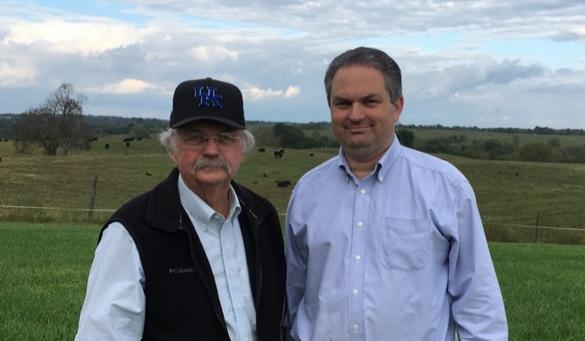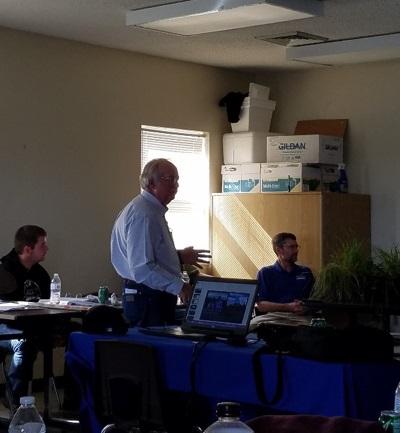Farm Highlight: Turpin Farm
 The Turpin Farm, owned and operated by Billy Glenn and his son, Scott Turpin, is a 155-acre farm stocked with a herd of spring and fall calving Angus/Simmental cattle. This farm has been family owned and operated for over 100 years. Billy Glenn Turpin retired from the Madison County school system as an agriculture teacher for 31 years.
The Turpin Farm, owned and operated by Billy Glenn and his son, Scott Turpin, is a 155-acre farm stocked with a herd of spring and fall calving Angus/Simmental cattle. This farm has been family owned and operated for over 100 years. Billy Glenn Turpin retired from the Madison County school system as an agriculture teacher for 31 years.
After he retired in 2001, drastic changes have taken place on what he calls his “Red House Farm.” They have stockpiled fescue in several paddocks to be used for late fall and winter grazing. Until the past four years, Billy Glenn and Scott’s main source of forage has been cool-season grasses. They have recently began planting and then grazing four acres of summer annuals. The use of a rotational grazing system has allowed them to increase their livestock numbers while providing better quality forage.
 Rotational grazing practices have increased pasture usage and allowed them to utilize more forage. This has practically eliminated supplemental feed and forages on their farm. The farm is divided into approximately 12 paddocks. Mr. Turpin told students at the EKU grazing school and attendees of the Kentucky Grazing Conference that the hardest part of designing his grazing system was deciding the location of watering sources. The farm uses seven permanent waterers which are heated to limit winter freeze ups. All of the waterers, except one, are supplied by a cistern pump from rain water collected off existing buildings. The water lines are all connected to the cistern pump house, but at the turn of a valve he can water his cattle with city water during drought conditions.
Rotational grazing practices have increased pasture usage and allowed them to utilize more forage. This has practically eliminated supplemental feed and forages on their farm. The farm is divided into approximately 12 paddocks. Mr. Turpin told students at the EKU grazing school and attendees of the Kentucky Grazing Conference that the hardest part of designing his grazing system was deciding the location of watering sources. The farm uses seven permanent waterers which are heated to limit winter freeze ups. All of the waterers, except one, are supplied by a cistern pump from rain water collected off existing buildings. The water lines are all connected to the cistern pump house, but at the turn of a valve he can water his cattle with city water during drought conditions.
When planning his fencing system, the water stations were placed so they could be easily accessed by multiple paddocks. When deciding how to improve his fencing, Mr. Turpin said, “Fencing was the easiest of all decisions.” Their farm has a boundary fence of five strand high-tensile wire with interior fencing system as single-strand poly-wire. The best investment was the use of temporary fencing that allows him to control the area his cattle graze. This system aids in the ability to change paddock sizes or even implement different grazing practices between and within a grazing season.
Since they started using a rotational grazing system, Turpin Farm has observed many benefits. The farm has increased stocking rates 25% due to the improved utilization of available forage. The most important aspect to their management is closely monitoring the pastures for adequate forage height. They have learned that it’s important to make sure that animals never over graze the forage. Leaving an adequate residual height is important so that the forage has reserves to grow back. This allows healthy plants to handle environmental stress, such as limited water availability.
Billy Glenn Turpin claims to be a forage farmer first. Both he and Scott strive to produce enough forage so none of their cattle receive any supplemental forage until after the first of January. They emphasize forage quality; they have reduced the need for stored feed; and they are striving to improve pasture utilization.
Categories:
General
Farm Highlights


